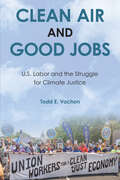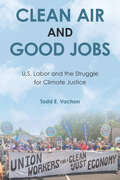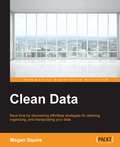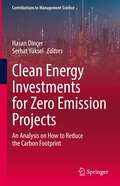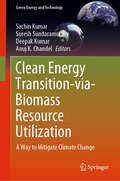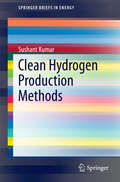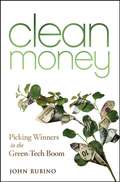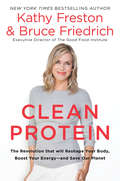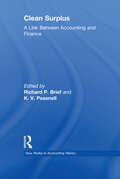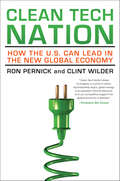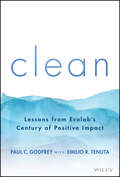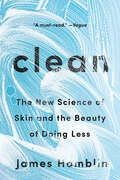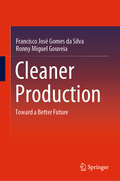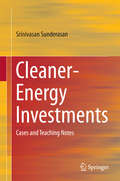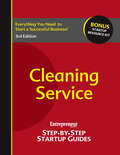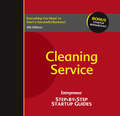- Table View
- List View
Clayton, Dubilier and Rice at 40
by Josh Lerner Abhijit Tagade Terrence ShuProfessor Josh Lerner and Research Associates Abhijit Tagade and Terrence Shu prepared this case. It was reviewed and approved before publication by a company designate. Funding for the development of this case was provided by Harvard Business School and not by the company. Josh Lerner has provided advisory services to Clayton, Dubilier & Rice. Joseph Rice has served as chair of the Private Capital Research Institute's Practitioner Advisory Board. HBS cases are developed solely as the basis for class discussion. Cases are not intended to serve as endorsements, sources of primary data, or illustrations of effective or ineffective management.
Clean Air and Good Jobs: U.S. Labor and the Struggle for Climate Justice
by Todd E. VachonThe labor–climate movement in the U.S. laid the groundwork for the Green New Deal by building a base within labor for supporting climate protection as a vehicle for good jobs. But as we confront the climate crisis and seek environmental justice, a “jobs vs. environment” discourse often pits workers against climate activists. How can we make a “just transition” moving away from fossil fuels, while also compensating for the human cost when jobs are lost or displaced? In his timely book, Clean Air and Good Jobs, Todd Vachon examines the labor–climate movement and demonstrates what can be envisioned and accomplished when climate justice is on labor’s agenda and unions work together with other social movements to formulate bold solutions to the climate crisis. Vachon profiles the workers and union leaders who have been waging a slow, but steadily growing revolution within their unions to make labor as a whole an active and progressive champion for both workers and the environment. Clean Air and Good Jobs examines the “movement within the movement” offering useful solutions to the dual crises of climate and inequality.
Clean Air and Good Jobs: U.S. Labor and the Struggle for Climate Justice
by Todd E. VachonThe labor–climate movement in the U.S. laid the groundwork for the Green New Deal by building a base within labor for supporting climate protection as a vehicle for good jobs. But as we confront the climate crisis and seek environmental justice, a “jobs vs. environment” discourse often pits workers against climate activists. How can we make a “just transition” moving away from fossil fuels, while also compensating for the human cost when jobs are lost or displaced? In his timely book, Clean Air and Good Jobs, Todd Vachon examines the labor–climate movement and demonstrates what can be envisioned and accomplished when climate justice is on labor’s agenda and unions work together with other social movements to formulate bold solutions to the climate crisis. Vachon profiles the workers and union leaders who have been waging a slow, but steadily growing revolution within their unions to make labor as a whole an active and progressive champion for both workers and the environment. Clean Air and Good Jobs examines the “movement within the movement” offering useful solutions to the dual crises of climate and inequality.
Clean Data
by Megan SquireIf you are a data scientist of any level, beginners included, and interested in cleaning up your data, this is the book for you! Experience with Python or PHP is assumed, but no previous knowledge of data cleaning is needed.
Clean Energy Investments for Zero Emission Projects: An Analysis on How to Reduce the Carbon Footprint (Contributions to Management Science)
by Hasan Dinçer Serhat YükselThis contributed volume analyses and discusses how atmospheric carbon emissions can be prevented using carbon capture and removal technology and how renewable energies can be used to reduce carbon emissions. Both approaches have their disadvantages. First of all, both involve high costs. Secondly, both require the use of advanced technology. As a result, many countries continue to use fossil fuels. The book seeks to address these problems by identifying strategies to increase countries’ use of clean energy. The authors discuss the dilemmas of zero emission and competition in the energy industry and illustrate cross-country applications of the current trends in the form of zero-emission business projects.
Clean Energy Transition-via-Biomass Resource Utilization: A Way to Mitigate Climate Change (Green Energy and Technology)
by Deepak Kumar Anuj K. Chandel Sachin Kumar Suresh SundaramurthyThis book highlights clean energy transition via sustainable utilization of biomass resources, viz. forestry, agriculture, agroforestry, grassland, and seaweeds to climate change mitigation. Bioresources have tremendous potential to mitigate global warming. Also, biomass is expected to play a multifunctional role including food production, source of energy and fodder, biodiversity conservation, and yield of goods and services to the society. It brings together perspectives of various communities involved in the research and regulation of bioenergy deployment in the context of climate change mitigation. The book presents the way forward to policy makers and stakeholders involved with bioenergy development. This development may be directive challenges in the transport sector where options such as hydrogen and electric vehicles relying on hydro, wind, and solar PV will require decades to become established on a substantial scale. Furthermore, meeting ambitious climate change targets will also require environment-friendly fuels in air and marine transport where no alternative to biofuels is currently available. The process design-via-onion model for sustainable utilization of biomass resources is also one of the most important subjects of the book. This book includes state-of-the-art approaches on bottlenecks and circular economy analysis for biomass energy use to reduce climate change and sustainability frameworks to guide bioenergy development.
Clean Energy for the Future
by Richard H.K. Vietor Howaida KamelThis is an industry note on renewable energy-wind, solar, governmental incentives and storage. It covers the recent history of both the wind and solar industries, an extensive look at governmental policies in the United States, including the Green New Deal, and supply-demand-price developments in those sectors.
Clean Hydrogen Production Methods (SpringerBriefs in Energy)
by Sushant KumarThis brief covers novel techniques for clean hydrogen production which primarily involve sodium hydroxide as an essential ingredient to the existing major hydrogen production technologies. Interestingly, sodium hydroxide plays different roles and can act as a catalyst, reactant, promoter or even a precursor. The inclusion of sodium hydroxide makes these processes both kinetically and thermodynamically favorable. In addition possibilities to produce cleaner hydrogen, in terms of carbon emissions, are described. Through modifications of steam methane reformation methods and coal-gasification processes, from fossil as well as non-fossil energy sources, the carbon dioxide emissions of these established ways to produce hydrogen can significantly be reduced. This brief is aimed at those who are interested in expanding their knowledge on novel techniques and materials to produce clean hydrogen and capture carbon dioxide at a large-scale. The detailed thermodynamic analysis, experimental findings and critical analysis of such techniques are well discussed in this brief. Therefore, this book will be of great interest and use to students, engineers and researchers involved in developing the hydrogen economy as well as mitigating carbon dioxide emissions at a large-scale.
Clean Money
by John RubinoIn Clean Money, John Rubino, Editor of GreenStockInvesting.com, introduces you to the world of clean tech (also known as green tech) and its wealth creation potential. Throughout the book, he explores a variety of clean energy sources-from solar power to biofuels-and shows how these renewable resources will spawn successful companies and rising share prices. Page by page, you'll discover the technologies that will drive this boom and become familiar with the state of their markets, their growth prospects, and the companies that are best positioned to become tomorrow's success stories.
Clean New World: Culture, Politics, and Graphic Design
by Maud LavinOur culture is dominated by the visual. Yet most writing on design reflects a narrow preoccupation with products, biographies, and design influences. Maud Lavin approaches design from the broader field of visual culture criticism, asking challenging questions about about who really has a voice in the culture and what unseen influences affect the look of things designers produce. Lavin shows how design fits into larger questions of power, democracy, and communication. Many corporate clients instruct designers to convey order and clarity in order to give their companies the look of a clean new world. But since designers cannot clean up messy reality, Lavin shows, they often end up simply veiling it. Lacking the power to influence the content of their commercial work, many designers work simultaneously on other, more fulfilling projects. Lavin is especially interested in the graphic designer's role in shaping cultural norms. She examines the anti-Nazi propaganda of John Heartfield, the modernist utopian design of Kurt Schwitters and the neue ring werbegestalter, the alternative images of women by studio ringl + pit, the activist work of such contemporary designers as Marlene McCarty and Sheila Levrant de Bretteville, and the Internet innovations of David Steuer and others. Throughout the book, Lavin asks how designers can expand the pleasure, democracy, and vitality of communication.
Clean Protein: The Revolution that Will Reshape Your Body, Boost Your Energyand Save Our Planet
by Kathy Freston Bruce FriedrichJoin the CLEAN PROTEIN revolution and lose weight, feel stronger, and live longer.Food and wellness experts Kathy Freston and Bruce Friedrich have spent years researching the future of protein. They've talked to the food pioneers and the nutrition scientists, and now they've distilled what they've learned into a strength-building plan poised to reshape your body and change your world.Complete with delicious recipes and a detailed guide to food planning, Clean Protein explains everything you need to know in order to get lean, gain energy, and stay mentally sharp. You'll finally understand in simple terms why protein is essential, how much you should get, and where to find the best sources of it.Clean Protein is a powerful solution to excess weight and chronic health issues, and it's a cultural revolution that will be talked about for decades.
Clean Surplus: A Link Between Accounting and Finance (Routledge New Works in Accounting History)
by Richard P. Brief K. V. PeasnellFirst published in 1996. The relationship between the present discounted value of future cash flows and discounted excess earnings should be viewed as a mathematical property of a double-entry book[1]keeping system based on clean surplus. The purpose of this anthology is to facilitate future research by highlighting these historical developments and by showing how more recent theoretical and empirical research fits into the earlier history. The book is divided into four sections: historical overview; analytical properties of clean surplus; the theory of the clean surplus equation; and empirical implications.
Clean Tech Nation: How the U.S. Can Lead in the New Global Economy
by Clint Wilder Ron PernickFrom Ron Pernick and Clint Wilder, the authors of Clean Tech Revolution, comes the next definitive book on the Clean Tech industry. In Clean Tech Nation, they shine a light on the leaders at the forefront of the growing movement. USA Today called Pernick and Wilder’s groundbreaking first book, “one of the few instances in this genre that shows the green movement not in heartstring terms but as economically profitable.” Clean Tech Nation expands on their original idea to provide concrete analysis on the efforts of the U.S. and other countries in this area, and provides a clear way forward for the U.S. so that it can lead the pack as it competes with the rest of the world.
Clean and Competitive: Motivating Environmental Performance in Industry
by Jim Skea Rupert Howes Bob WhelanReconciling wealth creation and environmental care is one of the key challenges in the pursuit of sustainable development. Companies considering greener modes of operation are mindful of their formal responsibilities to advance shareholders' interests. The age of globalization and intensified competition has increased disincentives to be 'green' for its own sake. And yet, a surprisingly high proportion of large companies have put in place environmental management regimes and invest considerable time and resources in them. However, the public continues to believe that these companies are failing to take their environmental responsibilities seriously, and campaigners are unimpressed with the results of industrial self-regulation. In short, there is a gulf in perception between industry and the consumer. Clean and Competitive explores the challenge of motivating industry to address environmental issues, drawing on work undertaken by Sussex University's Science Policy Research Unit (SPRU) and the Centre for the Exploitation of Science and Technology (CEST). The authors explore in detail industrial responses to prominent environmental issues, including: climate change, air quality, water pollution, waste minimization, and product recycling. They assess various approaches to environmental problems, such as: traditional regulation, partnership, voluntary agreements, and market-based instruments. Finally, they recommend practical ways forward for addressing an ever more complex environmental agenda. This thoughtful and articulate text is recommended for students on environmental management courses, policy makers, and environmental managers within industry.
Clean, Green and Responsible?: Soundings from Down Under (CSR, Sustainability, Ethics & Governance)
by Gabriel Eweje Ralph J. BathurstNew Zealand and Australia are broadly considered to be countries in which sustainability and responsibility discourses are being pursued by governments and business alike, and in which incentives and initiatives are helping confront and overcome sustainability-related challenges. This book takes a closer look behind and beyond the marketing mantras of both Australia’s and New Zealand’s “clean and green” campaigns and, on the basis of representative examples and cases, critically evaluates the status quo.The book assesses the effectiveness of sustainability and responsibility models with a focus on the South Pacific and argues that the ways in which issues have been dealt with in this more closely defined geographical region are most likely a good indicator of how similar issues are (or soon will be) dealt with around the globe. As such, the book offers a rich source of cases on sustainability and responsibility in the business arena, a critical review, and an inspirational affirmation of responsible business practice.
Clean: Lessons from Ecolab's Century of Positive Impact
by Paul C. Godfrey Emilio R. TenutaStraightforward strategies for achieving sustainable practices and business success in the modern organization In Clean: Lessons from Ecolab’s Century of Positive Impact, a team of veteran sustainability experts delivers a practical toolkit for creating a forward-looking and sustainability-focused business. From Ecolab’s origins in sustainability 100 years ago to its ambitious 2030 environment and social impact goals, this book lays out a roadmap for business transformation and continued growth – today and for the next 100 years. You’ll explore the principles and methods required to build and lead a sustainable company. You’ll discover how to evolve your focus on sustainability over time, as your organization transforms and grows. You’ll learn to: Build and maintain momentum for sustainability initiatives and cement your firm’s commitment to new practices through iteration and aligning business units around core, shared sustainability goals. Embed new sustainable practices into your organization’s governance and operations DNA Identify and leverage specific sustainability levers that impact a wide variety of key performance indicators Create a set of business processes that enable sustainable future and engage your employees in a higher purposeAn essential playbook for students of sustainability and business, this book is a must-read for the modern manager, executive, or director seeking to solidify their business strategy and future-proof their company. Clean: Lessons from Ecolab’s Century of Positive Impact describes the holistic and comprehensive approach to responsible business that we’ve all been waiting for.
Clean: The New Science of Skin
by James HamblinA preventative medicine physician and staff writer for The Atlantic explains the surprising and unintended effects of our hygiene practices in this informative and entertaining introduction to the new science of skin microbes and probiotics. Keeping skin healthy is a booming industry, and yet it seems like almost no one agrees on what actually works. Confusing messages from health authorities and ineffective treatments have left many people desperate for reliable solutions. An enormous alternative industry is filling the void, selling products that are often of questionable safety and totally unknown effectiveness. In Clean, doctor and journalist James Hamblin explores how we got here, examining the science and culture of how we care for our skin today. He talks to dermatologists, microbiologists, allergists, immunologists, aestheticians, bar-soap enthusiasts, venture capitalists, Amish people, theologians, and straight-up scam artists, trying to figure out what it really means to be clean. He even experiments with giving up showers entirely, and discovers that he is not alone. Along the way he realizes that most of our standards of cleanliness are less related to health than most people think. A major part of the picture has been missing: a little-known ecosystem known as the skin microbiome—the trillions of microbes that live on our skin and in our pores. These microbes are not dangerous; they&’re more like an outer layer of skin that no one knew we had, and they influence everything from acne, eczema, and dry skin to how we smell. The new goal of skin care will be to cultivate a healthy biome—and to embrace the meaning of &“clean&” in the natural sense. This can mean doing much less, saving time, money, energy, water, and plastic bottles in the process.Lucid, accessible, and deeply researched, Clean explores the ongoing, radical change in the way we think about our skin, introducing readers to the emerging science that will be at the forefront of health and wellness conversations in coming years.
CleanSpritz
by John A. Quelch Alisa ZaloshSales of CleanSpritz all-purpose cleaning spray have been steadily declining for the past five years, and management believes the decline correlates to a growing environmental concern among U.S. consumers. CleanSpritz's management is considering several options to address the environmental concerns in hopes of reversing the decline in revenue: re-launching the current product; adding a new product that includes stronger concentrate in a recyclable pouch; adding a new stronger concentrate in a dissolvable packet; or keeping the business status-quo. Students must present their recommendations for the most effective strategy, keeping in mind the potential risks of each alternative. Students learn to demonstrate the importance of packaging in the marketing mix, analyze the costs and benefits of being a first mover, and learn about the decision-making process for a product extension that represents a creative attempt to rejuvenate a mature brand. This case can be used in courses on marketing management, product management or new product development, or marketing and social responsibility.
CleanWater, Inc.: Running Dry & Out of Time
by Ramana Nanda Robert F. White James Barnett Shai BernsteinCase
Cleaner Production: Toward a Better Future
by Francisco José Gomes da Silva Ronny Miguel GouveiaThis book provides an overview of cleaner production, including how regulations have evolved, and presents a broad perspective on how it is being developed. Presenting several practical examples and applications of modern clean production technologies, it provides readers with ideas on how to extend these practices to other industry sectors in order to contribute to a better environment in the future.The authors start from the initial concepts of how to implement new cleaner production systems, before collecting recent developments in the area and demonstrating practical ways in which the latest knowledge can be applied. It motivates readers to develop new ideas on how to improve manufacturing systems to save energy and generate less waste, and discusses strategies on how to save, reuse and adapt materials, as well as techniques to reduce the waste and pollution produced.This book serves as a reference resource for industrial management engineers and researchers, and is also of interest to undergraduate and postgraduate students looking for insights into cleaner production in industry.
Cleaner-Energy Investments: Cases and Teaching Notes
by Srinivasan SunderasanThis book is a compilation of case studies from different countries and covers contemporary technologies including electric vehicles and solar thermal power plants. The book highlights the real-world situations facing individual projects and highlights the strengths and weaknesses of the underlying business propositions. It also sheds light on the factors that are routinely ignored during project formulation and risk assessment, namely coordination among public and private agencies, confirmed availability of relatively minor but essential components, possibility of concurrent demand for inputs from different project proponents, etc. The book provides a systematic 'guided tour' of renewable energy (RE) projects for potential project analysts and includes the development of financial models. It concludes with an evaluation of risk and the design of risk-mitigation measures. It is designed to simultaneously appeal to business school students and to serve as a guide for practicing executives, policy makers and consultants. The cases cover several countries, currencies, policy environments, technologies and resources and will help policy makers, consultants and project analysts and proponents view RE projects in a new light.
Cleaning Business
by Entrepreneur MagazineHouseholds are not the only places that require a thorough cleaning--so do offices, retail locations, and other businesses. The list doesn't end there--if it can be cleaned, chances are people will pay you to clean it. That's why few industries can claim the variety and depth of opportunities that professional cleaning can. And the vast majority of dual-income families use cleaning services, which means your market is huge.Most cleaning service businesses can be operated on either a part-time or full-time basis, either from home or from a commercial location. The best part is, you can build an extremely profitable business that will generate revenue very quickly with little initial investment!This in-depth guide shows you how to start three of the most in-demand cleaning businesses residential maid service, commercial janitorial and carpet/upholstery cleaning and offers invaluable insights on:Current statistics and trend forecasts that keep you ahead of the curveThe ins and outs of finding customersNew ideas for hiring and training employeesWhat equipment and supplies you'll need (and where to find them)How to use technology to make your business competitiveUp-to-date legal, tax and insurance requirementsHow to avoid common pitfallsSurefire tips for growing your businessIt also contains answers to frequently asked questions, an appendix of additional resources, and checklists to guide you through each step of the startup process. If you want to start your own successful cleaning business, take your first steps with our startup guide.
Cleaning Service
by Inc The Staff of Entrepreneur MediaThe experts at Entrepreneur provide a two-part guide to success. First, find out what it takes to start three of the most in-demand cleaning businesses: residential maid service, commercial janitorial service and carpet/upholstery cleaning. Then, master the fundamentals of business startup including defining your business structure, funding, staffing and more. This kit includes: Essential industry and business-specific startup steps with worksheets, calculators, checklists and more Entrepreneur Editors' Start Your Own Business, a guide to starting any business and surviving the first three years Interviews and advice from successful entrepreneurs in the industry Worksheets, brainstorming sections, and checklists Downloadable, customizable business letters, sales letters, and other sample documents Entrepreneur's Small Business Legal ToolkitMore about Entrepreneur's Startup Resource KitEvery small business is unique. Therefore, it's essential to have tools that are customizable depending on your business's needs. That's why with Entrepreneur is also offering you access to our Startup Resource Kit. Get instant access to thousands of business letters, sales letters, sample documents and more - all at your fingertips!You'll find the following: The Small Business Legal Toolkit Sample Business Letters Sample Sales Letters
Cleaning Up: Portuguese Women’s Fight for Labour Rights in Toronto
by Susana P. MirandaThis fascinating book uncovers the little-known, surprisingly radical history of the Portuguese immigrant women who worked as night-time office cleaners and daytime “cleaning ladies” in postwar Toronto. Drawing on union records, newspapers, and interviews, feminist labour historians Susana P. Miranda and Franca Iacovetta piece together the lives of immigrant women who bucked convention by reshaping domestic labour and by leading union drives, striking for workers’ rights, and taking on corporate capital in the heart of Toronto’s financial district. Despite being sidelined within the labour movement and subjected to harsh working conditions in the commercial cleaning industry, the women forged critical alliances with local activists to shape picket-line culture and make an indelible mark on their communities. Richly detailed and engagingly written, Cleaning Up is an archival treasure about an undersung piece of working-class history in urban North America.

